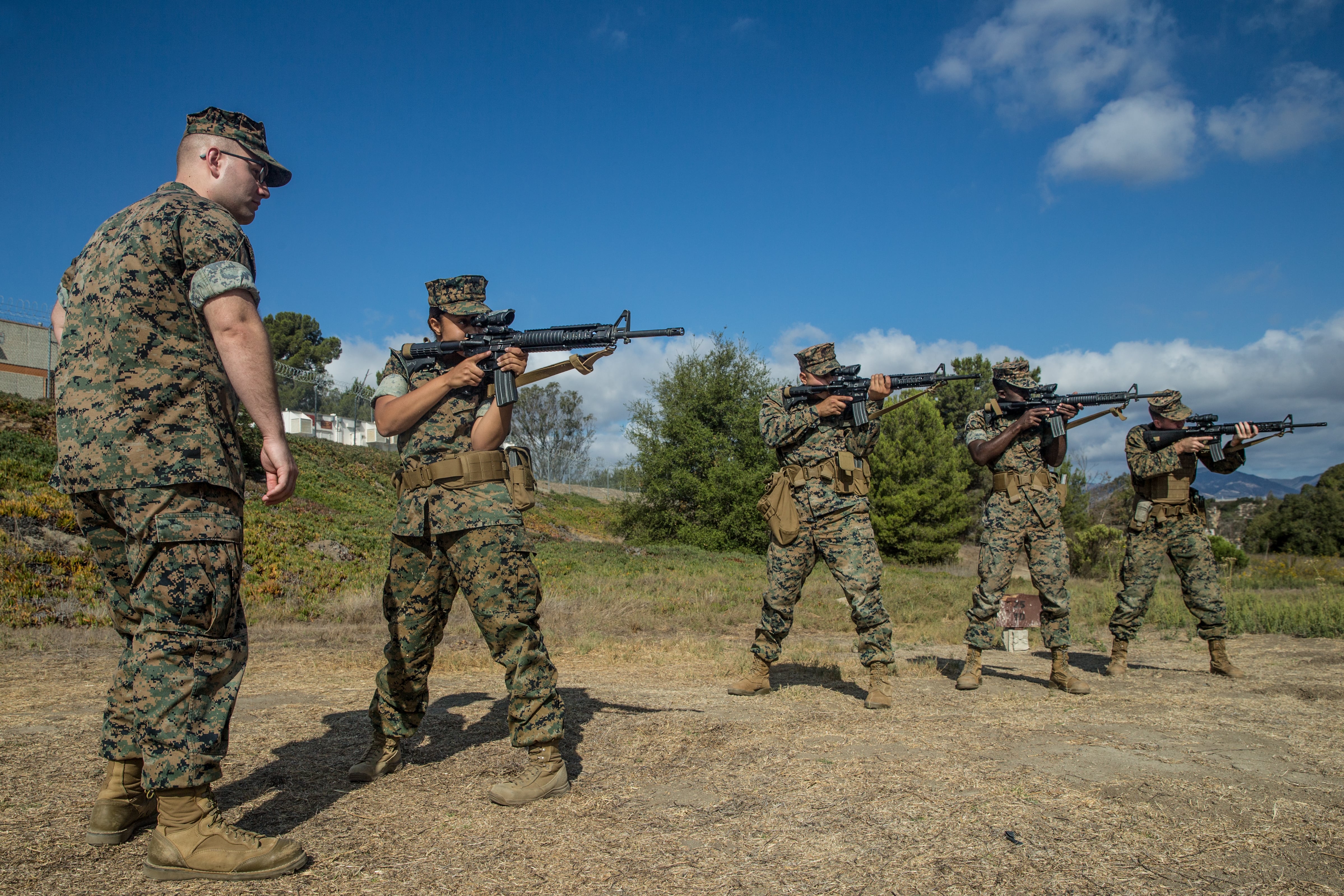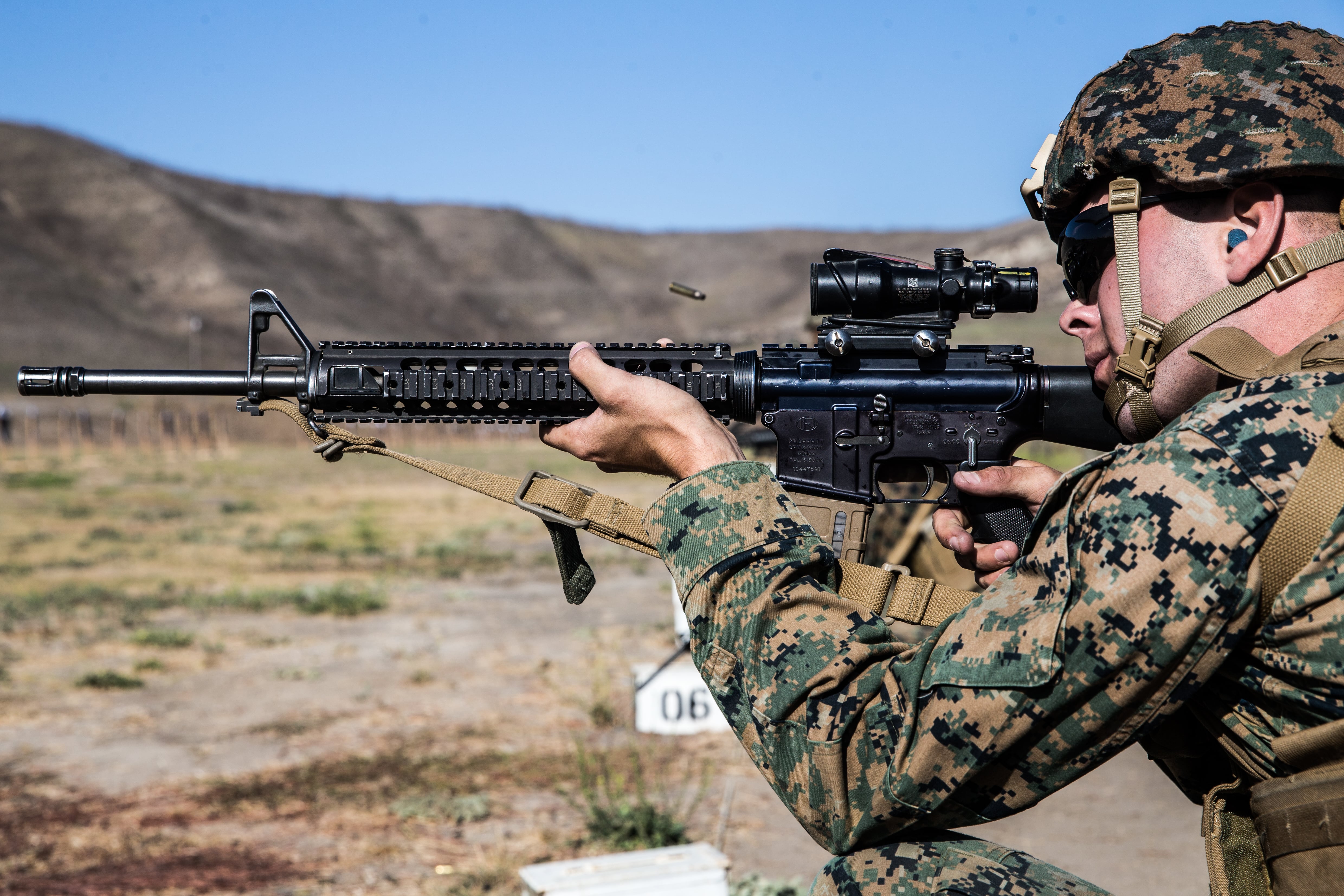MARINE CORPS BASE QUANTICO, Va. – On a windy December morning a small group of Marines with Weapons Training Battalion shot what might become the most drastic changes to the annual rifle qualification in nearly a century.
After years of feedback from marksmanship experts and operational commands across the Corps asking for a more realistic ― and shorter ― shooting qualification, a new experimental course of fire will be rolled out over the coming months.
If approved by both the community of shooting experts and command all the way to the commandant, the plan is to implement the new annual rifle qualification by 2021.
Weapons Training Battalion officials aim to gather data from 600 Marines across the force to best determine what the thresholds for qualification and the shooting badges of marksman, sharpshooter and expert.
“It will be more challenging,” Col. Howard Hall, commanding officer of Weapons Training Battalion, told Marine Corps Times.
That’s because shooters will be qualifying as they’ll fight.
They’ll wear combat gear, from helmet to body armor and shoot their assigned weapon, whether that’s an M4 or M16 or the M27.
Quick note: Recruit training marksmanship training will not change.
They’ll be drawing one third each from the ground combat element, aviation combat element and logistics combat element. And 7 percent to 10 percent of shooters will be female Marines.
One incentive for volunteering to shoot the new course is that Marines who do the three-day shooting course can take their qualification for their annual score and then forgo the one to two week annual rifle training, Hall said.
New course of fire takeaways:
- No longer slick. Marines will wear combat gear, helmet and body armor to shoot.
- Three days to qualify. One day of snapping in, zeroing, positions and a run through. Days two and three are the same, a prequalification and qualification day.
- Badges remain the same. Scoring thresholds still being determined.
- One target to rule them all. No more bull’s-eye or silhouette-style match targets. A single, exposed enemy target, the same size for all distances.
- This is for the fleet Marine forces. It does not change entry marksmanship training at recruit schools.
- More realistic. Moving targets, box shooting, failure to stop shots and head shots matter.
- No more sitting position. Only standing, kneeling and prone. Barricades positions at short range are up to the shooter.
- No more scoring on the line. Target pullers will mark destroy, neutralize, suppress or miss. Only destroys count.
- Less time. The longest exposure is five rounds at 500 yards for 45 seconds. The shortest is a single round, three second head shot at 25 yards.
- Starting long. Shooters will begin prequalification and qualification from the 500-yard line and work into the 25 yard line.
- Night fire for score. Shooters will be evaluated on the same short bay course, from 100 yards in, at night as they shoot during the day.
- Not just table I. Shooters will be shooting elements of all six tables in the overall course of fire.
In the new course, on day one Marines will run through zeroing the weapon, practicing holds and the shooting short, long and night fire courses, starting from close ranges and moving out to the 500-yard line.
Then on day two, they’ll start shooting from the 500-yard line and work their way in to the 300 yard, 200 yard, 100 yard, 25 yard and 15 yard lines. It’s the way Marines are trained to fight, close with and destroy the enemy; instead of the current method in which they begin at the shorter ranges and work backward.
That’s the entire course of fire, which they’ll repeat for qualification on day three.
Standing, kneeling and prone positions remain, but shooters can now use support. Their magazine, bipod and even rucksack can be used for support, just as it would in battle.
There’s no more sitting position, a holdover from competition match style shooting that informed the early days of Marine Corps marksmanship development.
And there won’t be any prescribed positions for barricade shooting at close ranges. If a shooter wants to stand or kneel or not use the support at all, it’s up to them.
Time might be the biggest factor. Marines now have 10 minutes to get off 10 shots from the 500-yard line.
Technically the actual shooting scenarios remain largely the same, only the course will include elements of all six tables of fire and now only uses one target, instead of the five different targets used by Marines for decades.
No more bull’s-eye-style “Able” or shoulder and head silhouette “Dog” or standing body “B-Modified" targets on the line.

The black-shirted, skull cap, sunglasses and bearded target sporting an AK-47 that Marines have grown to love to shoot will be the only target they’ll see ― from the 500 yard line to close range head shot practice.
That’s because the move is to get away from scoring and marksmanship match-style thinking and having Marines envision the lethality they’ll have to deliver when firing on human targets in combat.
To adjust the target, statistical data gathered from years of research on the lethal zones has been used to outline where on the target a bullet would cause incapacitating damage to the enemy.
There’s no more scoring rings. Marines pulling targets in the butts will simply check whether the round was a either a “destroy,” “neutralize,” “suppress” or “miss.”
Only destroys count for score.
And only the target puller is keeping track. That’s because once the clock starts to tick, the target remains exposed for the shooter to fire.
Instead of Marines firing a single round, waiting for it to be marked, noting where they hit and then adjusting fire when the target comes back up, the Marine will begin shooting once the target appears and fire until they’ve shot the rounds for that iteration.
For example, shooters have five rounds of sustained fire at 500 yards in 45 seconds. They’ll shoot all five and then set up for another iteration of five rounds. That’s the longest exposure and nearly the most rounds they’ll fire in one go.
In the short bay they’ll have to make a single, standing head shot in three seconds.
Just hitting black on a target doesn’t mean its necessarily down.
RELATED
See a draft scoresheet here
For example, data shows that people hit in the jaw will return fire, Chief Warrant ocs 4 Gunner Tony Viggiani said. So, that’s not a score if you don’t hit near the center line of the target’s head.
Cpl. Christopher Tankersley, on the range with Marine Corps Times in early December, has shot the experimental ARQ multiple times for the training battalion. The six-year Marine infantry veteran welcomes the changes.
“Our current rifle qualification is outdated, we don’t really use much of it in the Marine Corps outside of the rifle range,” Tankersley said. “Frankly, if someone’s not very good, they can still qual.”
That’s been proven by data that Weapons Training Battalion has gathered as well.
A Marine on the current annual rifle training can qualify without ever hitting black on a target. A Marine can make expert without ever hitting the target from the 500-yard line.
Marines basically return from their annual ranges, away from the unit for two or more weeks, with a score and a badge for promotion.
“Commanders across the fleet will cut out that time for training for their Marines and they will come back only marginally better, if better at all,” Hall said.
Sixty-five percent of Marines who shot the annual range in the past year qualified as expert. The Marine Corps made no scoring changes when it introduced optics to weapons qualification years ago, which resulted in a 5 percent increase in scores.

That doesn’t provide much detail for commanders to know how their Marines are shooting, said Viggiani.
Just like with a Physical Fitness Test or Combat Fitness Test, Marines will have to make minimum scores on each of the components of the annual rifle qualification, long bay, short bay and night fire.
That makes for a more complete shooter.
As director of marksmanship for the Marine Corps at Weapons Training Battalion, Viggiani also said that it will require Marine combat marksmanship coaches and trainers to better tailor their training methods and recognize that teaching Marines to shoot isn’t a one size fits all approach.
As the annual rifle qualification is being further tested, the battalion is making changes to the training courses for coaches and trainers, Hall said.
But, a lot of the work will fall on the unit training managers.
They’ll have more shooting data to look at and be able to see weak spots for their shooters before they head to the three-day range for qualification.
Lance Cpl. Evelyn Alvarez, 19, shot the annual rifle qualification for the first time on the recent Quantico, Virginia, range. She’s an administrative clerk with the training battalion.
She preferred it to the course she’d shot recently in recruit training.
“The difference between recruit training and this ARQ, I feel it’s more realistic, it will prepare every Marine, female or male, for an actual combat scenario,” she said.
Both she and Tankersley said the new adjustment was the reduced time, though all of the shooters were able to get their rounds off in the time limit.
Alvarez said an immediate difference she notice was keeping her gear in position so that she could acquire and fire on the target.
Tankersley advised shooters to give the moving targets more lead time, as they looked smaller and moved faster than the moving targets he’d shot on previous ranges.
Todd South has written about crime, courts, government and the military for multiple publications since 2004 and was named a 2014 Pulitzer finalist for a co-written project on witness intimidation. Todd is a Marine veteran of the Iraq War.




